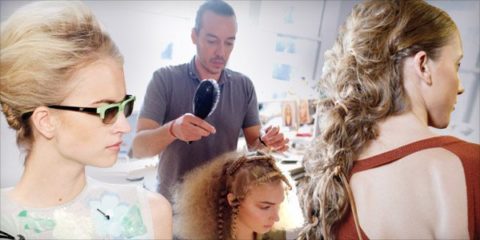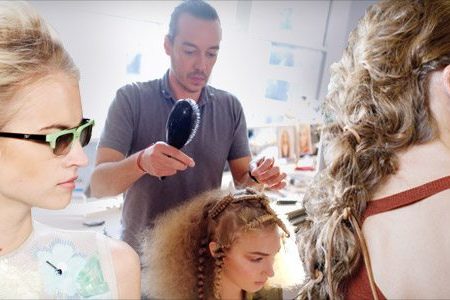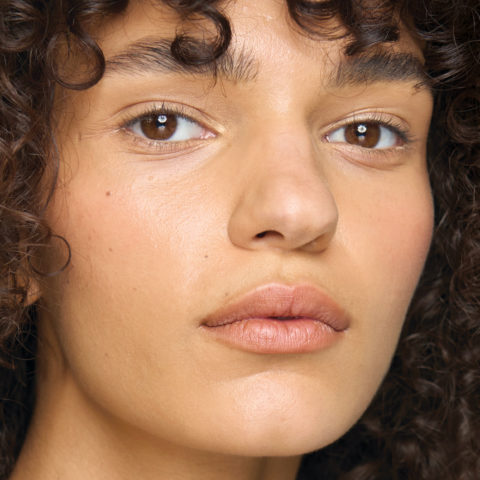Exclusive: We get some time with Orlando Pita, one of the industry’s biggest hairstylists


He’s one of the most influential hairstylists working today, but Orlando Pita would rather not be in the spotlight. Lesa Hannah manages to pin him down.
If you’re a beauty editor backstage at a fashion show and you want to interview Orlando Pita about the hair, you soon learn the following: If there isn’t a publicist to facilitate a chat, you’ll have to take matters into your own hands and approach him. Once you have him, be quick and to the point. Do not film him without his approval; if you raise your Flip camera unannounced during the interview, he will stop talking. Finally, for the love of God, do not ask how the real woman can recreate the look at home; his frustration with the question will be immediately apparent.
Feeling like you must delicately navigate around getting a sound bite from Pita can be intimidating, but the creator of looks for the runways of Oscar de la Renta, Christian Dior and Yves Saint Laurent makes no apologies for the fact that cameras make him uncomfortable. Or that his priority backstage is getting the hair done right, not speaking to the media. “If I’m doing an interview, I will walk away from it and go help somebody do hair, because it may be 20 minutes before the show and we have 15 more girls to do,” he says matter-of-factly over the phone from his home in Manhattan. While he doesn’t resent having to answer questions, he explains that when he started working at the collections, no one was backstage reporting. Instead, beauty editors would call for a recap once the season had wrapped. “It was in the early ’90s that you started seeing cameras backstage,” he says. “I was working with [Jean Paul] Gaultier and Karl Lagerfeld back then, and they love the camera. They taught me that I had to do this.” As for why he’ll never give the instructions on how to replicate a look: “Most of the things I do, I try to do so a woman can’t do it at home, so I still have a job.”
Pita’s first job had nothing to do with hair; it was on Wall Street, where he was a redemption clerk, cashing stocks and bonds. While he had an interest in hairdressing—he hated the cuts he got as a kid so he attempted to teach himself, practising on the heads of friends and family—he considered it a hobby. “I wasn’t licensed. It wasn’t something that I thought I could do.” That is, until the day his brother, working as a photographer’s assistant, called with an opportunity. The hairdresser booked for a shoot had cancelled with no notice, and the client needed a replacement. Pita stepped in and styled the hair for an eight-page shoot for a trade magazine called Sportswear International. Shortly thereafter, he secured an agent.

In 1984, only 21 and competing for work with more experienced stylists of the time such as Didier Malige and Julien d’Ys, Cuban-born Pita decided to move to Paris from New York. “My first job was with Peter Lindbergh,” he says. “Right away I got to work with good people, but I didn’t know who they were. My thinking was more, ‘My God, I got a job.’” The relocation allowed him to continue learning his craft. “I was in training, basically, for the first couple of years, but not letting people know that.” Clearly, no one caught on; Pita returned to New York a few years later with a thick book of editorial tear sheets, though because the styles that had been requested of him in Paris were so creative, it was too “avant garde.”
“Most of the things I do, I try to do so a woman can’t do it at home, so I still have a job.”
He happened to meet photographer Pamela Hanson on a train and ended up shooting with her, proving in the process that he could do “pretty hair.” Though he’s now a master at both approaches, he doesn’t favour one over the other, for fear of being labelled. He also refuses to single out one creation from the course of his career. “I’m not nostalgic at all,” he says. “It’s what I am going to do that interests me, not what I have done.”
Pita does play favourites with his tools, though: Mason Pearson brushes, for instance. “Once I like something, I’m loyal to it,” he says. “I can use that for 20 years. I’m not looking for the next big thing.” The T3 hair dryer is another item held in high esteem, but it was only because the company sent it to him twice that he actually gave it a try—the first time, he dismissed it as a toy since it was so lightweight. While he went on to develop a collection of styling products for the company, he insists on not exclusively representing one brand, so he can pay lip service to whatever he genuinely likes. “For some people, once their line comes out, they don’t talk about anything else,” he says. “That’s just a marketing strategy, and it’s not really being truthful to your craft.” This sentiment will be tested when he launches his own line this fall.
Products are merely the building blocks of the always beautiful and sometimes fantastical styles he crafts—he’s incorporated everything from garbage bags to screws in them. His ideas can be sparked by anything. “It could be a building, the way a letter is written or a certain swirl that I think would be nice to replicate in hair,” he says. “I love being inspired by things that have nothing to do with hair.” One has to wonder, though, given how in-demand Pita is: does he ever run out of ideas? “There can always be an ‘I don’t know’ moment, that’s for sure, even after 28 years. But 10 years ago I realized that I don’t have to worry, because the teams I work with change with each job.”
Despite rarely thinking of us mere mortals on the sets of glamorous shoots, major fashion shows and luxury ad campaigns, Pita does love getting his hands on a “real” woman’s hair. In fact, it was the feeling that he had lost touch with everyday people because he wasn’t cutting their hair anymore that led him to open his New York salon, Orlo, in 2005. For Pita, it’s not just about the cachet of styling models and A-listers—he shares the simple pleasure enjoyed by pretty much every hairdresser: “Making somebody feel good about their hair.”







